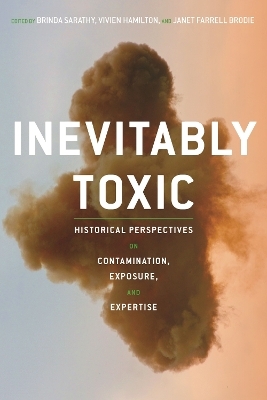
Inevitably Toxic
University of Pittsburgh Press (Verlag)
978-0-8229-6612-8 (ISBN)
- Lieferbar
- Versandkostenfrei
- Auch auf Rechnung
- Artikel merken
Not a day goes by that humans aren’t exposed to toxins in our environment - be it at home, in the car, or workplace. But what about those toxic places and items that aren’t marked? Why are we warned about some toxic spaces’ substances and not others? The essays in Inevitably Toxic consider the exposure of bodies in the United States, Canada and Japan to radiation, industrial waste, and pesticides. Research shows that appeals to uncertainty have led to social inaction even when evidence, e.g. the link between carbon emissions and global warming, stares us in the face. In some cases, influential scientists, engineers and doctors have deliberately “manufactured doubt” and uncertainty but as the essays in this collection show, there is often no deliberate deception. We tend to think that if we can’t see contamination and experts deem it safe, then we are okay. Yet, having knowledge about the uncertainty behind expert claims can awaken us from a false sense of security and alert us to decisions and practices that may in fact cause harm.
Brinda Sarathy is a professor of Environmental Analysis and director of the Robert Redford Conservancy for Southern California Sustainability at Pitzer College. She is the author of Pineros: Latino Labour and the Changing Face of Forestry in the Pacific N Vivien Hamilton is an associate professor of history of science and director of the Hixon-Riggs Program for Responsive Science and Engineering at Harvey Mudd College. Her work examines the history of medical technologies, focusing on questions of authority, expertise and cross-disciplinary collaboration. She holds a PhD in history of science from the University of Toronto and is currently completing a book examining the role of physics in the early history of radiology. She is a member of the History of Science Society, The Canadian Society for the History and Philosophy of Science and the Society for the Social Studies of Science. Janet Farrell Brodie is a professor of U.S. history at Claremont Graduate University. Her recent scholarship focuses on secrecy in the nuclear era with articles in the Journal of Diplomatic History and The Journal of Social History.. She is currently finishing a book about the history of the site of the first atomic bomb test in New Mexico and how it became a national historical landmark. She has a Ph.D. in history from the University of Chicago.
Introduction
Toxicity, Uncertainty, and Expertise Vivien Hamilton and Brinda Sarathy
Part One: Radiation
1. X-ray Protection in American Hospitals Vivien Hamilton
2. Contested Knowledge: The Trinity Test Radiation Studies Janet Farrell Brodie
3. Crossroads in San Francisco: The Naval Radiological Defense Laboratory and its Afterlives Lindsey Dillon
4. Born Opaque: Investigating the Nuclear Accident at the Santa Susana Field Laboratory William Palmer
Part Two: Industrial Toxins
5. Making Way for Industrial Waste: Water Pollution Control in Southern California, 1947-1955 Brinda Sarathy
6. Processing the Past into Your Future: Uncovering the Hidden Consequences of Industrial Development in the West Texas Petrochemical Industry Sarah Stanford-McIntyre
7. Vast, Incredible Damage: Herbicides and the US Forest Service James G. Lewis and Char Miller
8. Los Angeles's Neighborhood Oil Drilling and Environmental Justice Bhavna Shamasunder
Part Three: Community Contestation, Expanding Expertise
9. Atomic Bomb Survivors, Medical Experts, and the Endlessness of Radiation Illness Naoko Wake
10. On Sovereignty, Deficits, and Dump Fires: Risk Governance in an Arctic “Dumpcano Alexander R.D. Zahara
Epilogue
Containment: Discussing Nuclear Waste with Peter Galison
Interview by Vivien Hamilton and Brinda Sarathy
| Erscheinungsdatum | 21.06.2019 |
|---|---|
| Reihe/Serie | History of the Urban Environment |
| Zusatzinfo | 13 b&w |
| Verlagsort | Pittsburgh PA |
| Sprache | englisch |
| Maße | 152 x 229 mm |
| Themenwelt | Medizin / Pharmazie ► Pharmazie |
| Studium ► 2. Studienabschnitt (Klinik) ► Pharmakologie / Toxikologie | |
| Naturwissenschaften | |
| Technik ► Umwelttechnik / Biotechnologie | |
| ISBN-10 | 0-8229-6612-3 / 0822966123 |
| ISBN-13 | 978-0-8229-6612-8 / 9780822966128 |
| Zustand | Neuware |
| Haben Sie eine Frage zum Produkt? |
aus dem Bereich


